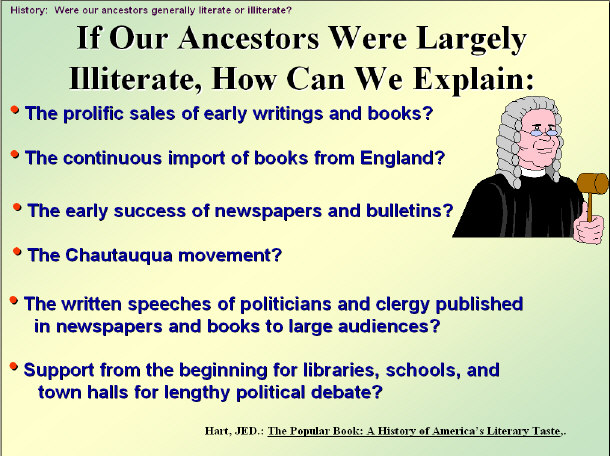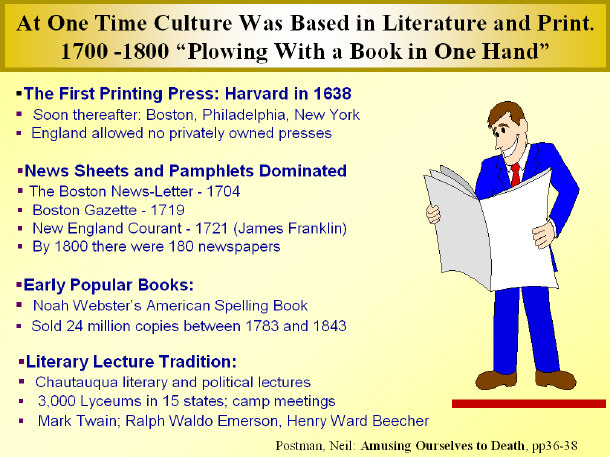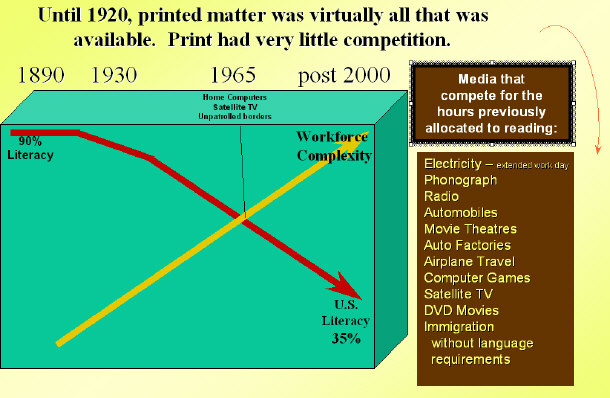
Mission Statement - American Literacy Council.
Short History of the American Literacy Council. Close This Window
A History of Literacy Initiatives in the United States and the Role of the American Literacy Council.
There are five alleged causes for the Literacy dilemma in the United States. The number of people who can not read continues to go up, largely because of the flow of millions of Spanish-speaking people who flow across the southern borders from Mexico. Those few who apply for citizenship generally learn to speak and read English as a requirement of that process. But, with over 2.5 million people who not only can't read English, but who also cannot speak the language, the illiteracy rate increases every day.
Thoughtful writers have identified five causes of illiteracy. Scholars write books describing two or more of these causes as being the problem that needs to be attacked.
The five causes are:
1. US history of illiterate rural population centers
2. Schools that introduce experimental new teaching methods
3. Social factors created by the breakdown of the American family
4. Government refusing to establish uniform standards for immigration and employment
5. The English language with it's highly erratic system of spelling
In this summary of literacy initiatives in the US, the first cause above will be analyzed and largely refuted. There is a basis for supporting causes two to five above, but not the first one.
Arguments supporting the idea that immigrants who settled the United States during it's first one hundred years were dominantly illiterate are summarized in this graphic:

President John Kennedy's book "A Nation of Immigrants" documented hundreds of ethnic groups and languages that had to be assimilated upon arrival at Ellis Island. He also explained the requirement laid upon each man, woman, and child to demonstrate their reading and writing skills. Failing to pass the test, they were required to attend classes whose only goal was to learn the English language, with testing to prove that they could read and write its written form.
Mutineer's book "Chesapeake" described second, third, and forth generation of people who cleared land and established early centers of population along the Eastern seaboard.
Here we find illiteracy indeed. Land owners would put their name on lists waiting to receive women prisoners from England and Ireland. True, with mail-order wives and men dedicated totally to clearing land and struggling to survive, the few requirements for writing were passed to township or regional clerks where contracts and deeds of sale were executed.
It's true also that slaves were almost universally prevented from learning to read. Eventually this produced a significant segment of the US illiterate population as the civil war eventually delivered slaves into an equally unforgiving world that provided few paying jobs for people who lacked reading skills. Farm hands and migrant workers were still imprisoned mentally and socially, prevented from rising in stature, both financially and socially.
Many writings document slave owners who would discover a slave studying letters. Soon that slave would be tied to a tree facing the tree, while others were forced to watch as clubs and axes were used to beat Achilles tendons until they were broken, never to be restored. That slave would always walk with a visible slow pace and flapping feet. There were many other torturous penalties in that social structure for those who learned to read.
Factors that give proof of the general demand for literacy is found in historic town meeting agendas and recorded meeting discussions.
The first buildings to be erected in every new-forming community: the school, the church, a town hall, followed by a library building. Each of these physical structures expressed the priority of literacy as a social value.

Many people today can recall stories or memories of their grandparents or great grandparents. Most of them knew how to read and write, order wagons, equipment, and even pre-fab houses from Sears-Roebuck catalogs. Prior to 1930, a large segment of the population went to one room school houses where the older ones taught the younger ones.
The McGuffy reader was the dominant textbook across a 90 year period and the emphasis was on learning to write, read and "do numbers" to the extent required to grow up to become successful farmers, shop owners, and community leaders. Almost every town had a central assembly hall where lecturers and politicians gave lengthy discourses on local issues.
From 1640 to 1660 the famous Bao Psalm Book was purchased by nearly every household. In 1682 one bookseller in Boston imported 3,421 books from one English dealer. Booksellers in each region imported books to serve a population of 75,000 people living in the northern colonies. JD Hart (page 15) extrapolates to show the scope of readership and imports if done in equal proportion today.
The religion of Calvinist Puritans demanded that they be literate. Male literacy in England at that time was about 40%, but the migrants who banded together to settle in New England were bonded by common beliefs that were spelled out in the books they brought . From 1650 onward, almost all New England towns passed laws requiring reading and writing schools. Larger towns added grammar and arithmetic also.
Learning meant book learning, a moral and intellectual imperative. In 1736 booksellers advertised these books and opinion papers: The Spectator, The Tattler, Steele's Guardian, Locke's Essay Concerning Human Understanding, Pope's Homer, Swift's writings, and Dryden's Fables. A well researched treatise on this topic is found in Neil Postman's Epic study "Amusing Ourselves to Death," Viking Penguin, NY 1986, pp 31-34.
In 1772 Jacob Duche wrote: "The poorest labourer upon the shores of the Delaware thinks himself entitled to deliver his sentiment in matters of religion or politics with as much freedom as the gentleman or scholar. Such is the prevailing taste for books of every kind, that almost every man is a reader." The Boston News-Letter began publication in 1704 and is generally regarded as the first continuously published American Newspaper. Then the Boston Gazette in 1719. By 1730 there were seven newspapers published regularly in four colonies and by 1800 there were 180 newspapers.
Charles Dickens lectured through the larger cities in 1842, stating that never a king or emperor on earth was so cheered and entertained at splendid balls and dinners. His lectures drew enormous crowds because about 90% of the citizens were literate and had read Dickens many works. Then Harriet Beecher Stowe sold 350,000 copies of Uncle Tom's Cabin in its first year of publication. From 1840 to 1930 Chataqua seminars and lectures were a major national attraction in the absence of Disneyland technology and entertainment. Chataqua was the preferred entertainment destination.

Prior to 1920, virtually all public discourse was debated in the framework of printed material. Without electronic media, print had no competition. Even lecturers spoke as though they were reading with long flowing sentences, usually because they had written and often memorized them.
Jonathan Edwards, the most brilliant writer and thinker in early America lectured and preached widely before his call to be President at Princeton University. He read all his speeches and sermons. His writings are prized evidence of the literate culture which bred him.
There is more print available today in 1997 than ever before. But it has enormous competition from other media. Until about 1920, print and literary lectures were once the channel and measure of all public discourse. Alex de Tocqueville wrote that “Americans speak to you as though they were addressing a meeting, and if they warm to their discussion, they will say Gentlemen to the person with whom they are speaking as though addressing a crowd.”
In 1854 in Peoria, Illinois, Douglas delivered a three-hour address, to which Lincoln by agreement was to respond. When his turn came, he stated that he would need at least as much time as Douglas had, and proposed that everyone go home, have dinner, and return for four more hours of lecture on political issues. They came back to hear it all. Lincoln and Douglas were not presidential candidates at that time.
Early American newspapers had no pictures because of the scarcity of paper and the cost of artists to create block-cut pictures. Advertisements were written with text only using long literary sentences. With the invention of photographs, ads began to include pictures, then slogans. With the advent of radio and TV, economy of time introduced slogans, clipped sentences, and telegraph styles in advertising and subsequently into most popular literature and political debate.
People who cannot read today rely on radio and TV to provide pictures and icons as a new and radically different means of obtaining information.

Simply stated, in 1900 90% of the US population could read and write. When electronic technology was embraced by the culture, hours formerly spent in reading were now fragmented as attention divided to include TV, movies, computer games and other electronic diversions. For some who were forced by their jobs to read computer manuals, they either already knew how to read, or they were eliminated from those opportunities. And when the requirement to learn to speak and read the English language was dropped, many millions of people are now left behind, trapped in a circle of non-reading people, excluded from jobs involving technology and electronics.
At a time when the work-foce need higher levels of literacy to understand the meaning of message on computer screens and in computer manuals, we have two thirds of the culture unable to read adequately and therefore unable to participate and find fulfillment in the opportunities of this complex culture.
Even literate persons are bewildered when dealing with fax machines, programmable VCR's with or without hard disks, Just learning to use a few of the features on a cell phone can be challenging, and the microwave oven blinks 12:00 in many kitchens. Try resetting your digital alarm clock. Then imagine yourself totally unable to read or write. We need a literate society. But with more than one million people entering the U.S. who not only cannot read English, but they cannot speak it, we face something like a free-fall unless readers here can innovate, battle for literacy, and introduce new methods to displace failed programs of the past.
Quotations here are from the ["One Liners and Famous Quotes"] section of this web site.
How many people did AT&T have to interview before they found 1,200 people with adequate reading and writing skills? The answer is 6,000.
Which country spends more per pupil than the United States? One - Switzerland.
How many states require high school graduates to demonstrate at least 8th grade reading competency? Thirty.
Which country has three times higher illiteracy than Russia? The United States.
How many naval recruits recently failed to meet required reading and writing tests? 30 percent.
Extracting thoughts from Frank Laubach in his book "Teaching the World to Read," "There cannot be education without literacy. Film, lectures, movies, radio, television cannot lift the economic and cultural plight of people who remain illiterate. Locked up in writing are all the great secrets and discoveries the human race has produced in the last 8,000 years.
In summary, ninety percent of the US population was literate from about 1700 to 1930. Then illiteracy began to increase as reading standards for citizenship were relaxed, illegal border crossing grew to over one million people per year, family breakdown increased, and learning environments in inner city schools include threatening guns, drugs and violence.
In a virtual free fall, literacy rates have dropped from 90% to 30% - and the decline continues.
Please support the efforts of the American Literacy Council in this worthy struggle lest the values of civilized society become lost in storms of violence and dissatisfaction experienced by those excluded from personal fulfillment and social participation. The ALC President can be reached in Boulder Colorado at (303) 440-7385.
Mission Statement - American Literacy Council.
Short History of the American Literacy Council. Close This Window